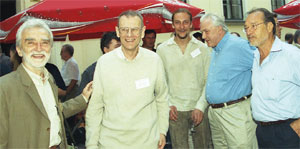As preparations for the start-up of the LHC continue to gather pace, a meeting in Cracow gave physicists the opportunity to take time to look to the exciting physics in store.
About 200 physicists were in Cracow on 3–8 July to attend Physics at LHC 2006, organized by the Henryk Niewodniczanﳳki Institute of Nuclear Physics of the Polish Academy of Sciences and the University of Science and Technology, and hosted by the Polish Academy of Arts and Sciences. The third conference in the series, it should be the last to review only plans, expectations, hopes and nightmares related to the Large Hadron Collider (LHC). The next conference, in 2008, should summarize some first results.

Jos Engelen, CERN’s chief scientific officer, opened the 2006 conference with a review of the status of the LHC project: apart from small delays, it should run on schedule. The rest of the first day focused on the Higgs problem. Robert Harlander of the Bergische Universität Wuppertal presented a theoretical overview of Higgs particles in the Standard Model (SM) and its various extensions. Vanina Ruhlmann-Kleider from Dapnia and Guillaume Unal from CERN then reviewed LHC plans, and Oscar Gonzalez Lopez of the Centro de Investigaciones Energéticas, Medioambientales y Technológicas, Madrid, reviewed results from Fermilab’s Tevatron. Several further talks by experimentalists and theorists considered specific “Higgs discovery potentials” for LHC experiments in various decay channels.
The second day focused on supersymmetry (SUSY). CERN’s Peter Jenni and Ludwik Dobrzynﳳki of the Laboratoire Leprince-Ringuet presented the plans that the ATLAS and cmS collaborations have, respectively, for searching for SUSY particles. Jan Kalinowski of Warsaw University gave a theoretical overview of the subject both within and beyond the minimal supersymmetric SM (MSSM). He stressed that new physics at the tera-electon-volt scale is almost unavoidable, and that SUSY seems to be the best candidate. Elemer Nagy of the Centre de Physique des Particules de Marseille presented a summary of Tevatron results on SUSY, and CERN’s Maria Spiropulu gave a general review of the LHC’s potential in this field. Further talks followed on specific problems of SUSY particles and searches at the LHC, including astrophysical aspects.
A short session on the morning of the third day covered diffractive physics, and included a report on the HERA for LHC workshop by Albert de Roeck of CERN and a theoretical review by Joachim Bartels of the University of Hamburg. Valentina Avati from CERN described the TOTEM experiment, which will investigate diffractive physics at the LHC.
Fermilab’s Joseph Lykken began the fourth day with an overview of theoretical physics, Standard Model and Beyond. He appealed for so-called “negative results” of searches for SM violations to be treated as exciting discoveries that may bring new understanding in particle physics. Marek Zielinﳳki of Rochester University and Chris Hays of Oxford University reported on Tevatron results of SM tests, and Maarten Boonekamp of CEA/Saclay described the possibilities at the LHC. Stefan Pokorski of Warsaw University presented various theoretical routes beyond the SM (other than the MSSM). Sung-Won Lee of Texas Tech University reported on related searches at the Tevatron, and Reyes Alemany-Fernandez of the Laboratório de Instrumentação e Física Experimental de Partículas in Lisbon looked forward to the LHC. There were also more specific short talks.
Heavy flavours and heavy ions shared the fifth day. Ikaros Bigi of Notre Dame University gave an inspired theoretical review of heavy-flavour physics, and Jianming Qian of Michigan University and Rainer Bartoldus of SLAC reported on results from the Tevatron and B-factories, respectively. CERN’s Tatsuya Nakada presented the future LHCb experiment. In heavy-ion physics, Carlos Salgado of the University of Rome “La Sapienza” and Gunther Roland of MIT presented theoretical and experimental reports, respectively. In this session, Eugenio Nappi of INFN reported on the ALICE experiment and other perspectives of heavy-ion research at the LHC. In the afternoon, parallel sessions covered more specific problems in both subjects.
The last day looked further into the future. Brian Foster of Oxford University presented the status of the International Linear Collider study, and Masa Yamauchi of KEK described the plans for super B-factories. Peter Saulson of Syracuse University looked at present and future searches for gravitational waves, and Pierre Binetruy of APC-Collége de France discussed the plans that astroparticle physicists have for the LHC and elsewhere, in particular the Laser Interferometer Space Antenna project.
CERN’s John Ellis concluded the day and reflected on events beyond the conference by presenting past, recent and future events around the LHC as a World Cup football match: from the training camps, team selections and preparation, through the first and second half including injury time, and the extra time and penalty shooting. This corresponded to the early planning of the accelerator and experiments, forming the collaborations, detailed planning and construction, future early measurements, planned upgrades of detectors, possible necessary unexpected changes and plans for future accelerators. He stressed very strongly the role of the first LHC results in further planning. For example, it is quite possible that these results may prove that the energy range of a future electron linear collider must be far beyond present plans.
The conference was a success and showed the broad scope of problems to be dealt with at the LHC. It led to many new ties between existing members of the LHC community and others present, who may soon become involved in this great particle-physics adventure. The speakers, representing both the LHC management level and enthusiastic young physicists, allowed a better understanding of the unique role that this project will play in developing particle physics.
The organizing committee assured the smooth running of the conference and a pleasant atmosphere. All the participants are looking forward to the next conference in the series, in which the first LHC results should be presented.
Further reading
All talks and posters are available at http://newton.ftj.agh.edu.pl/physLHC/. In February 2007, Acta Physica Polonica B will publish the conference proceedings, which will soon afterwards be freely accessible at http://th-www.if.uj.edu.pl/acta/.








